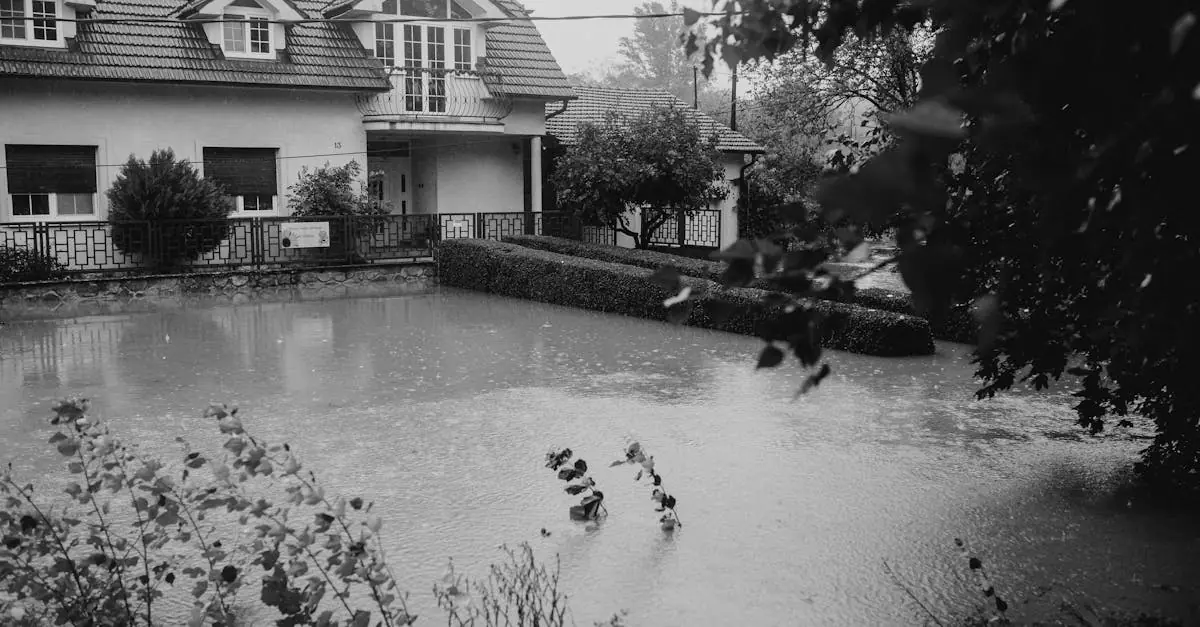Table of Contents
ToggleWhen a storm rolls through and a tree decides to play a game of dodgeball with your roof, the last thing anyone wants is to be left holding the bill. Homeowners insurance can feel like a safety net, but does it really have your back when it comes to tree damage? Spoiler alert: it’s not as straightforward as it seems.
Understanding Homeowners Insurance
Homeowners insurance encompasses various types of coverage, offering protection for a homeowner’s property. Property damage, including trees and landscaping, often falls under this umbrella. Coverage typically includes damage from covered perils like fire, theft, and certain weather events.
Insurance policies generally classify tree damage in two main ways: falling trees and damage caused by tree removal. Falling trees might receive coverage if they cause direct damage to structures. Homeowners should review their insurance policy details to confirm specific protections and restrictions.
Coverage often excludes damage caused by routine wear or lack of maintenance. For instance, if a tree falls due to its decay, insurance may deny the claim. Homeowners must maintain their trees to avoid potential issues and ensure that their property is safe.
In the instance of storms, policies might cover damage caused by trees falling onto a home, vehicle, or other insured property. However, clarity on this varies with different insurers and policies. Homeowners should discuss coverage limits and exclusions with their insurance agent to obtain accurate information.
Understanding the nuances of homeowners insurance aids homeowners in making informed decisions. Each policy contains distinct terms regarding tree damage, making it vital for homeowners to read their documents carefully. Direct questions to the insurer can clarify the policy’s language and terms.
What Tree Damage Is Typically Covered
Homeowners insurance often includes coverage for certain types of tree damage. Understanding these specifics helps homeowners navigate their policies effectively.
Types of Insured Damage
Falling trees represent one major type of covered damage. If a tree falls on a home, garage, or other structures, the insurance policy typically covers repairs. Damage caused by storms, such as strong winds or heavy snowfall, generally falls under this coverage. Insurance may also cover the cost of removing fallen trees from the property. If the tree causes damage to personal property, such as vehicles or fences, that damage often qualifies for coverage as well. Exceptions may arise, especially if maintenance issues contribute to the damage.
Exclusions to Consider
Certain exclusions can limit coverage for tree damage. Routine maintenance neglect could result in a denied claim. If a homeowner fails to maintain a tree that eventually falls, insurance may not cover that incident. Additionally, damage occurring due to natural causes, which are not covered perils, often falls outside homeowners insurance. For instance, if a tree dies from disease and then falls, that situation might not qualify for coverage. Homeowners should review their specific policy details and speak with agents to clarify exclusions.
Factors Affecting Coverage
Homeowners insurance coverage for tree damage hinges on specific details. Various factors influence whether a claim will be approved, ultimately affecting the financial protection available.
Policy Variations
Coverage can differ significantly between insurance policies. Some policies offer comprehensive protection for trees and landscaping, while others exclude certain scenarios or damage types. Not all insurance providers define “perils” in the same way. Certain policies may cover damage caused by falling trees, while others may categorize it as maintenance negligence. Homeowners should closely examine their policy documents. Reading through the fine print clarifies coverage limits and exclusions related to tree damage. Discussing the policy with an insurance agent helps ensure complete understanding of the specific protections in place.
Location and State Laws
Geographical location plays a crucial role in determining coverage specifics. Different states have varying regulations and guidelines regarding homeowners insurance. Some regions experience more frequent severe weather events, prompting insurers to adjust policies accordingly. State laws often dictate coverage requirements and exclusions affecting trees on properties. For instance, homeowners in hurricane-prone areas may find enhanced coverage for storm-related damage. Understanding state-specific regulations can assist homeowners in evaluating their insurance options. Consulting local insurance experts offers further clarity on what homeowners can expect regarding tree damage claims.
How to File a Claim for Tree Damage
Filing a claim for tree damage involves specific steps. Homeowners must gather necessary documentation and follow a structured claims process.
Documentation Needed
Collect relevant information to support the claim. Start with photographs of the damage, showing the fallen tree and the affected property. Include any repair estimates or invoices related to the incident. It’s essential to have an appraiser’s report if available. Gather all correspondence with the insurance company, including previous claims or communications. Also, keep a record of maintenance performed on the tree, as it may help in proving the cause of damage.
Steps in the Claims Process
Begin by notifying the insurance agent about the tree damage. Complete the claims form provided by the insurance company accurately. Include detailed descriptions of the incident and corresponding documentation. After submission, maintain regular contact with the claims adjuster, who will assess the damage. The adjuster may request additional information or an on-site inspection. Respond promptly to any requests to expedite the claims process. Review the claim’s outcome carefully; if it gets denied, understand the reasons and consider an appeal if justified.
Tips for Homeowners
Homeowners can take proactive steps to protect their properties and understand their insurance coverage regarding tree damage.
Preventive Measures
Maintaining trees plays a vital role in preventing damage. Regular inspections for weak or diseased branches help identify potential hazards. Trimming overgrown limbs can reduce the likelihood of falling trees during storms. Securely fastening trees with guy wires can provide additional support. Additionally, removing dead or dying trees can prevent accidents and subsequent damage. Homeowners benefit from hiring certified arborists for professional evaluations and maintenance recommendations.
Choosing the Right Policy
Selecting the right homeowners insurance policy directly affects coverage against tree damage. Various policies offer different levels of protection. Some comprehensive plans cover falling trees that damage structures and include removal costs. Exclusions may apply for damage due to neglect or pre-existing conditions, so thorough policy examination is essential. Homeowners should consult agents to clarify coverage limits and specific exclusions. Understanding state regulations and coverage offerings can make informed decisions easier.
Homeowners need to be proactive when it comes to understanding their insurance coverage for tree damage. The nuances of policies can lead to confusion and potential financial loss if homeowners aren’t fully informed. By maintaining their trees and regularly reviewing their insurance policies, they can ensure they’re adequately protected against unexpected damage.
Consulting with insurance agents and local experts can provide clarity on coverage specifics and exclusions. With the right knowledge and preparation, homeowners can navigate the complexities of tree damage claims more effectively. Ultimately, staying informed and taking preventive measures can significantly reduce the risk of costly surprises.





